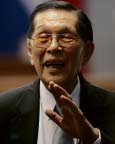
Since the 1980s, a close circle of friends and I would be at the Ponce Enrile residence for Saturday evening Mass in the Enriles’ private chapel Cristina built, for she was a very pious woman, whose piety and many charitable good works would one day be rewarded with the Papal award, Pro Ecclesia et Pontifice.
She had also served once as Ambassador to the Holy See. We would join them for dinner in their elegant dining room with a long rectangular dining table seating 16, beneath crystal chandeliers.
Juan Ponce Enrile would be at the cabecera; his inamorata, as I heard him once call her, to his left. To JPE’s right, in the place of honor, would be the priest who celebrated the Mass.
Dinner conversation would invariably turn to the book JPE had been working on for three or so years. I would ask him: “Johnny, where are you now in your autobiography?”
Once, he announced: “I’m now in the martial-law years!”
He explained he himself had typed the draft proclaiming martial law on his typewriter in his study at their Urdaneta Village residence when they were living there in the ’70s. He didn’t want it to leak out, he said.
Turning to us, he said he could never forget how, at a large function in Malacañang’s Heroes Hall, at the beginning of martial law, the First Lady made the generals wear straw skirts and dance the hula. The ridiculous image of Generals Espino, Rancudo, Ramos, Zagala and Admiral Ruiz wearing lipstick and sashaying in ladies’ heels, was obviously still so vivid in his mind. He said he was so disgusted.
Agreeing, Cristina exclaimed: “Que asco, Tabasco!”
She had a way of making us laugh with her funny rhymes. On one occasion, when JPE reported to her he had forgotten to say something to someone before that person left for abroad, she exclaimed, “Oh Daddy, it’s too late, chocolate.”
Because the biography was my genre when I took my MA in Creative Writing in University of the Philippines, I was most curious to know how JPE was writing his memoirs. I offered my unsolicited advice that he should include setting, description, and dialogue and create scenes; that he shouldn’t just summarize. (Of course, all these I learned from my faculty and thesis adviser, Cristina Pantoja Hidalgo.)
Well, it turns out I needn’t have worried. Certain parts of his book, in fact, read like a novel. I am impressed with his ability to recall and describe in detail how Aparri looked like in those days, mentioning the names of the persons who had touched his life.
I marveled at his prodigious memory, and asked him if he had kept a journal. He said he had notes of important events and his impressions of them.
He had narrated to us a few times how the Japanese prison where he was incarcerated looked like, how he was tortured, and how he escaped. What he had recounted to us is all in his book, a veritable page-turner. I urge everyone to read it.












































